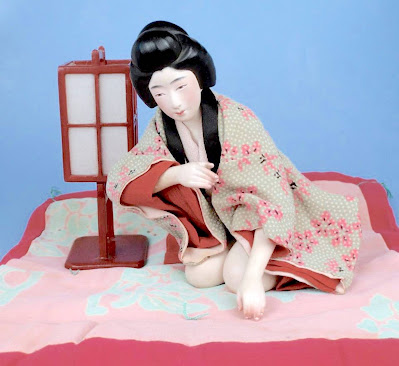This beautifully modeled and dressed doll is known as a sosaku-ningyo (creative or art doll). Beginning in the 1920s, some Japanese doll artists began to experiment with classical Japanese doll making techniques.
These artists used traditional doll-making methods and materials, like gofun, the smooth white porcelain-like finish made from ground oyster shells, to created art dolls that strove to be more natural and life-like. This bewitching bijin (beautiful woman) is 4.5 inches tall and comes dressed in her original miniature silk kimono. Although her arms appear to be slightly jointed (perhaps to aid in dressing her), the rest of her body is a single piece. The silk mat, which matches some of the material in her kimono, also appears to be original, and the miniature lantern came with her as well. This doll may date from the 1950s.
She is exquisite from any angle. The sculpting and painting are very detailed, from her complex hairstyle to her serene face to the carefully delineated fingernails. The miniature kimono is perfectly tailored to fit her.
. . .very anatomically correct. There is a long tradition of exotic art in Japan. The shunga (spring pictures) were vivid and unashamed artistic depictions of sexual activity and pleasure, often portrayed with playfulness and humor. The development of woodblock printing allowed these enticing images to be reproduced and shared. Although officially banned, these woodblock prints were very popular and sold on the sly. Many of the famous artists of the day contributed to the genre and their creations are prized by connoisseurs. This delicate doll demonstrates the traditional Japanese merging of erotica and art.









